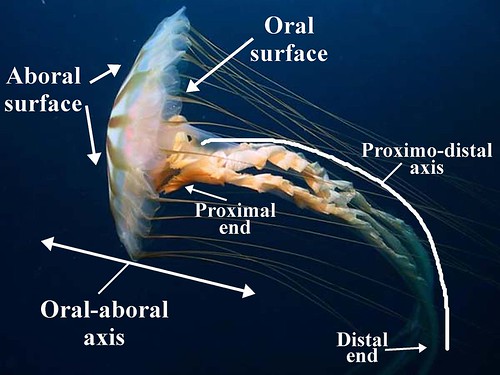Hi £ers!? I hope you're having a good Wednesday so far! Today, I went hiking with some friends at El Yunque National Forest, specifically to El Toro Wilderness Peak (3,524 ft/1,074 m), the highest peak in the forest and the only tropical wilderness in the United States National Forest System. It was super relaxing (once you get to the top that is lol) and a good workout too!
Pic by me
Though walking at a decent clip, we had to slow down and make a few stops along the way due to numerous mud traps and heavy rain. It took us about 3.5 hours to reach the top -- normally a 2.5 hour hike -- and 2.5 hours to descend through a different and safer trail. While we were resting at the top, I started to play with the soil and noticed the abundance of very old and fossilized marine organisms like mollusks and cnidarians.
And how did they get there?!? Well, through different periods and stages of our planet those mountains were covered by salt water and... Jellyfish! :D

sheldon0531 / Via Flickr: sheldon0531
Did you know? Some jellyfish are larger than a human adult and some are as small as a pinhead? What?! Amazine!
Giant Jellyfish, photo by Echizen Kurage
Inmortal Jellyfish (3.5mm), photo by Kevin Raskoff
Jellyfish have been on Earth for millions of years, even before dinosaurs. Their swimming technique also helps them to capture prey; when their body expands it displace more water which brings more potential prey within the reach of their tentacles. Though jellyfishes do not have brain, some of the species have eyes or some type of photoreceptors (ocelli) "light seeking organs". Jellyfish bodies are primarily composed of water and protein with one layer of cells on the outside and another lining the internal cavity.

Richard Schneider / Via Flickr: picturecorrect
There are many different types of jellyfish, including stinging kinds called medusae
and comb jellies called ctenophores.
Purple Striped Jelly, photo by Sanjay Acharya
Flower Hat Jelly, photo by Kenpei J. (Osaka Aquarium, Japan)
Lion's Mane Jelly, photo by Dan Hershman
White Spotted Jelly, photo by Magnus Manske
Moon Jelly (Aurelia), photo by Hans Hillewaert
Ctenophores comb, Photo by Jui Navarra
Jellyfish anatomy, illustration by US NOAA (public domain)
And how long does jellyfishes live? Not much sadly. Most jellyfish live less than a year and some other only live for a few days. The life stage at which people are more familiar with, is the medusa stage where the creature has hanging tentacles all around. But this medusa form is only one part of jellies life cycle!
Male and female jellyfish reproduce and form thousands of tiny larvae called planulae. Then this larvae anchor to anything at the ocean floor from rocks and reefs to organisms as corals, sponges, mollusks shells, sturdy algae and the like. Once the larvae is anchored, it grows and form a small polyp that resembles a small sea anemone. From each polyp, many baby jellyfishes are released and they are called ephyrae. This ephyrae stage is VERY short and the organism grows rapidly into an adult jellyfish.
1–3 Larva searches for site
4–8 Polyp grows
9–11 Polyp strobilates
12–14 Medusa grows
Illustration by Matthias J. Schleiden
Some jellyfish have millions of tiny stinging cells on their tentacles called nematocysts. These cells are super touch sensitive and are used to capture food by injecting toxins and neutralizing the prey. Imagine a tiny tiny but TINY micro harpoon with a mechanic trigger that's operated by a chemical reaction. Once the natural chemicals found in your skin come into contact with the nematocysts, these are instantly activated. If you have a wet suit on and a jellyfish touches you, the nematocyst aren't activated but as soon as you (or anybody) touch your wet suit with bare skin they go off anyways as they do not depend on being attached to the jellyfish to be functional.
One misconception regarding jellyfishes and the Portuguese Man o' War, is that the latter is not technically a jellyfish. It's actually a siphonophore that's made up of more than one separate creature, but it is so awesome and pretty, that I thought it deserved a mention on this Science Wednesday. Another main difference between these two different species is that the Man o' War doesn't "swim", it floats on the surface of the water thanks to its gas-filled bladder, leaving its tendrils full of nematocysts to sweep the depths below for yummy plankton and unfortunate fish.
Photo by Geoff Schultz
And you may be thinking, what are the benefits of these beasts?!? Well, jellyfishes are very important animals in ocean ecosystems. We definitely should respect them. They are food for a number of large marine animals such as fish and turtles. Even humans in some parts of the World eat jellyfish! Jellyfishes also provide habitat and protection for many commercial juvenile fish in areas where there are not many places to hide. Another curious fact is that many young crabs climbs on top of jellyfish to save energy and avoid having to swim! Hitchhiking anyone?!? Cool! lol
And that's all my favorite SBNation comrades! Till next Wednesday! Hit the vid at the break for an awesome Jellyfish documentary.
One of my girlfriends at the Baltimore National Aquarium, Pic by me.
















